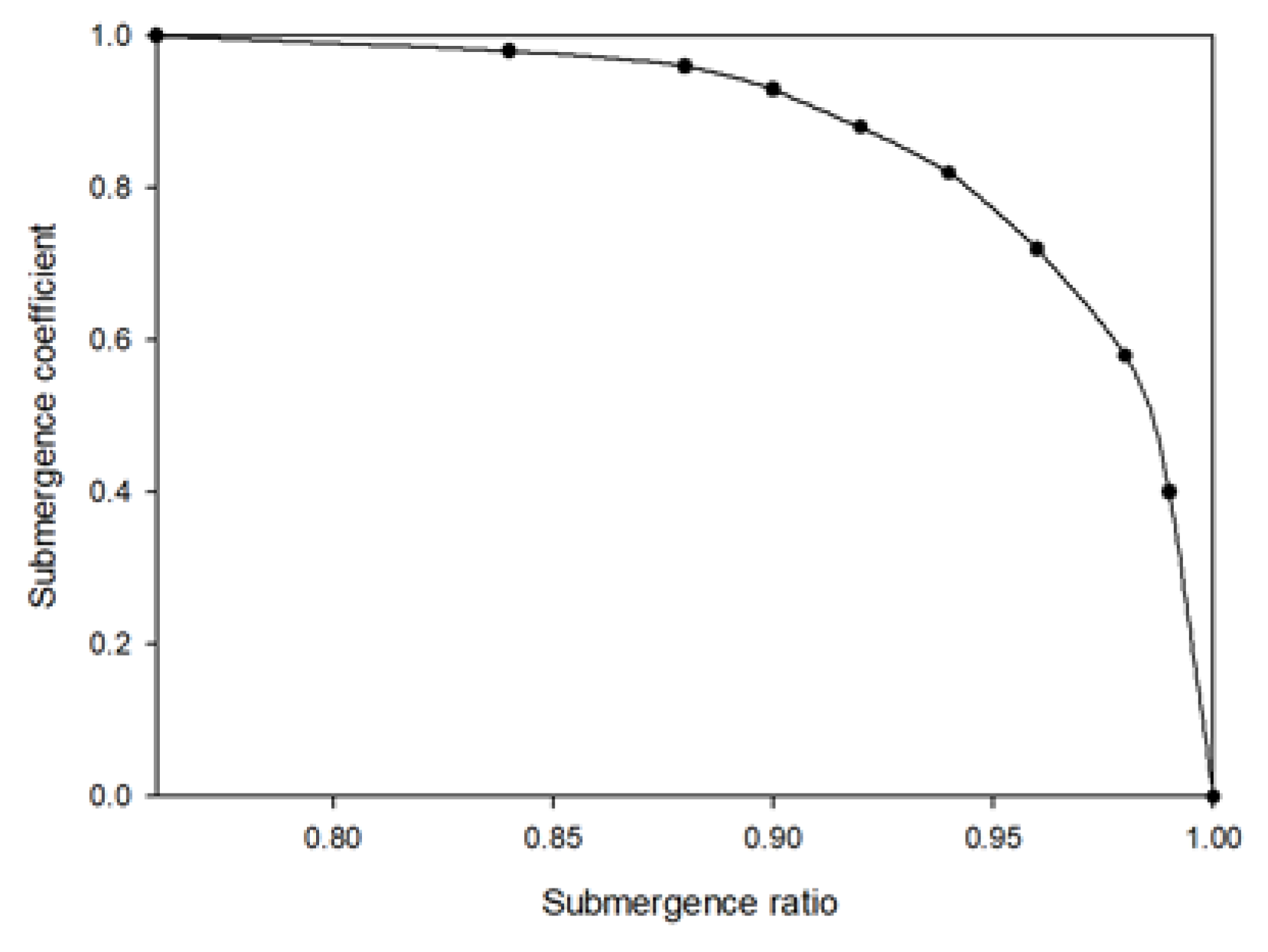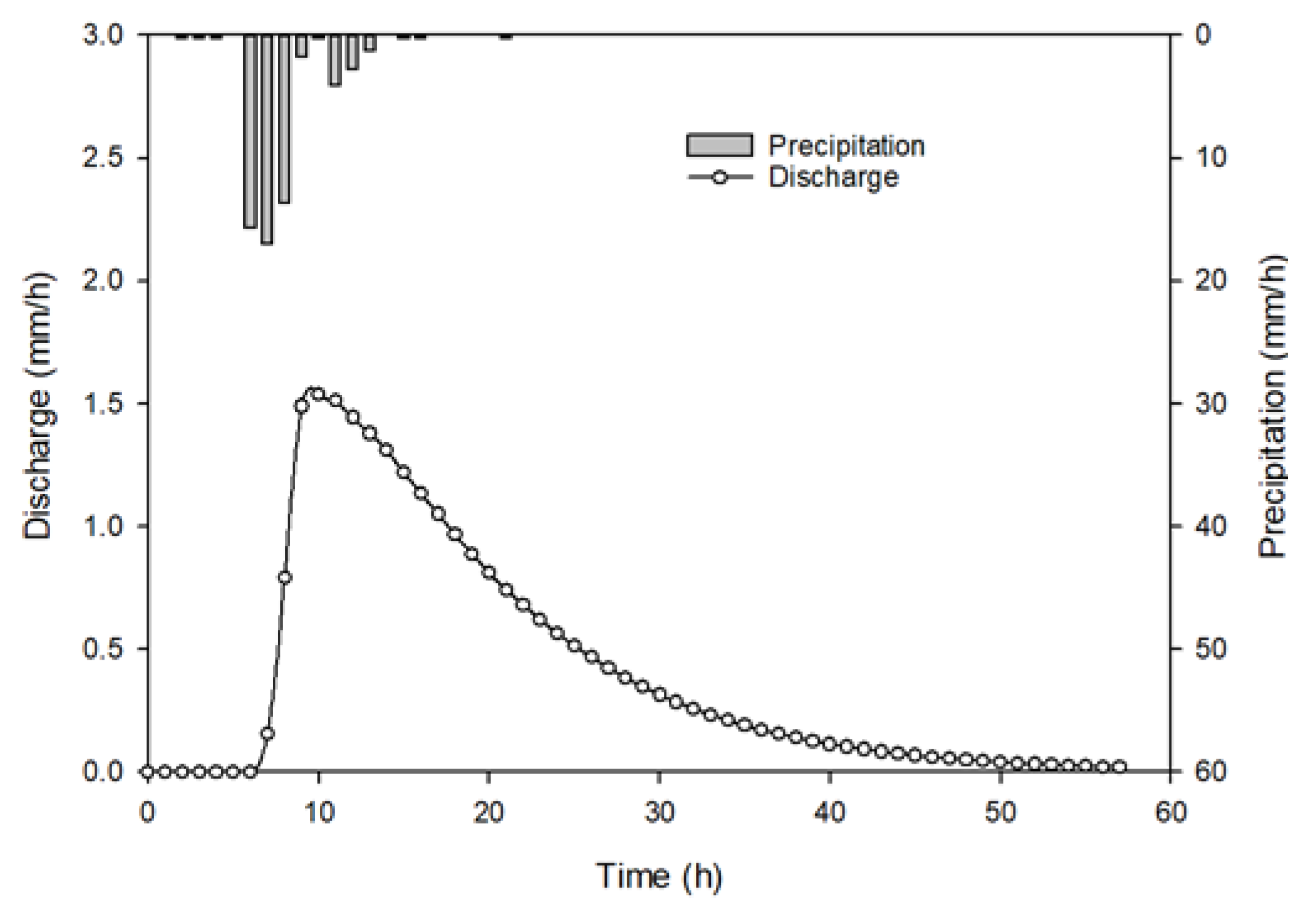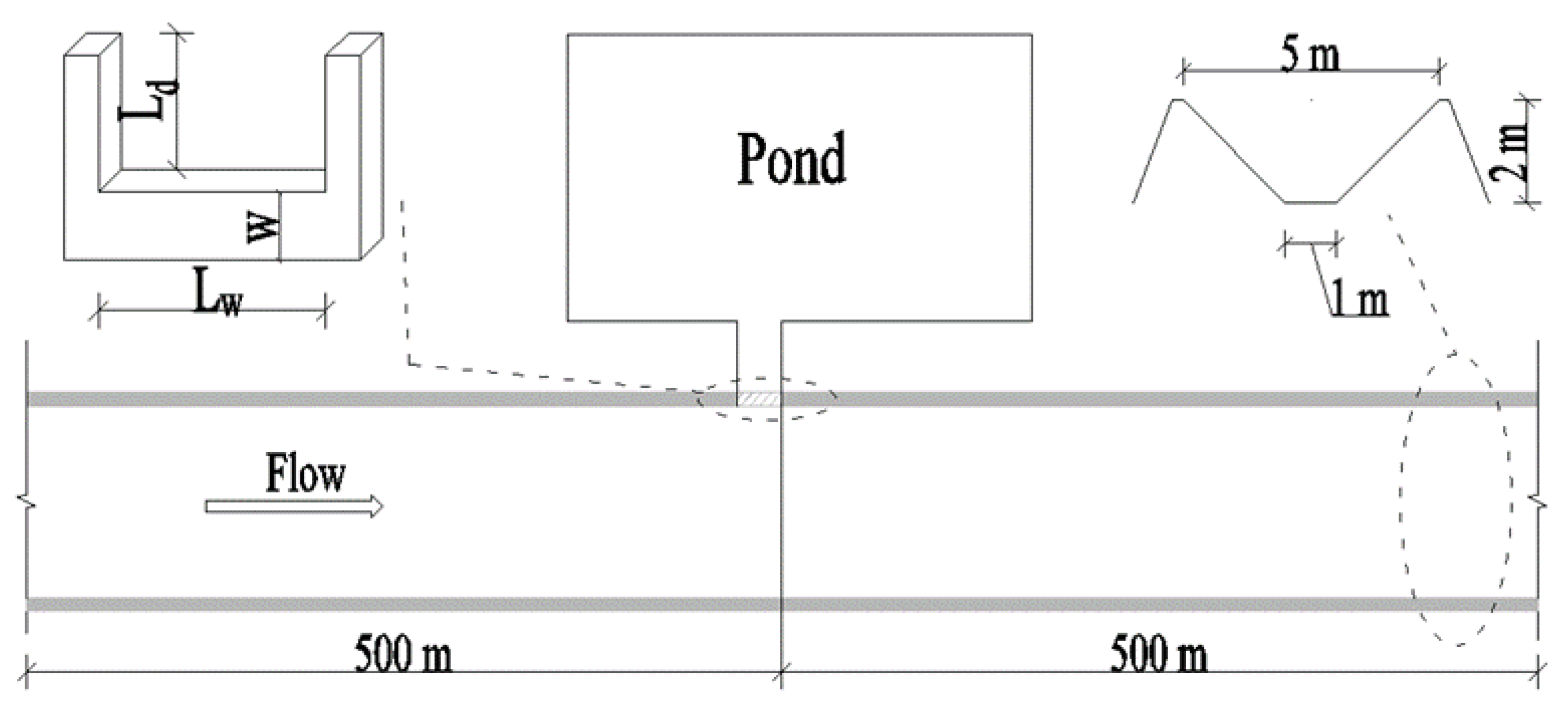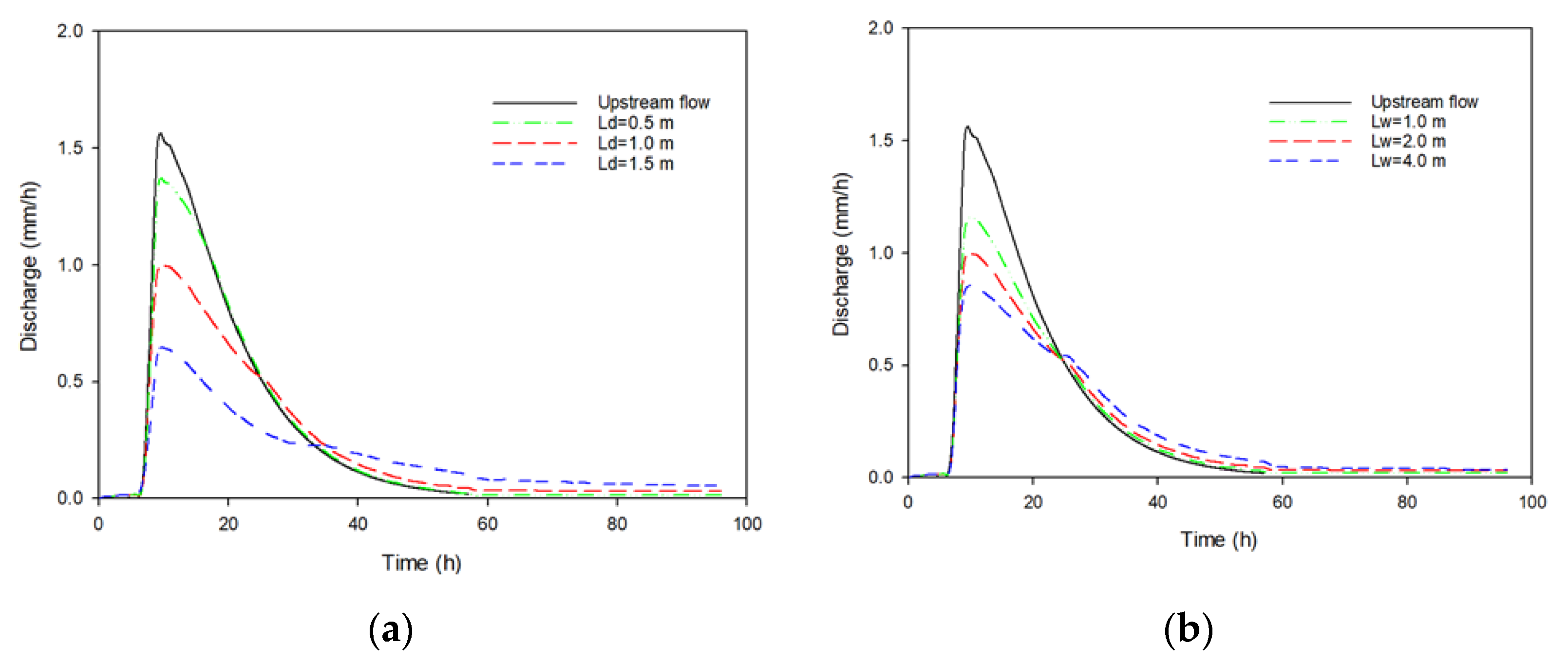Evaluation of Drainage Water Detention Efficiency of Off-Line Ditch-Pond Systems and Its Influencing Factors
Abstract
:1. Introduction
2. Evaluation of Drainage Detention Performance
2.1. Evaluation Indices and Influencing Factors
2.2. Calculation of Drainage Detention by an Off-Line Pond-Ditch System
3. Study Site
4. Results and Discussion
4.1. Analysis of Influencing Factors
4.2. Evaluation of Detention Performance
4.3. Analysis of the Hydrograph
5. Conclusions
- (1)
- , , and affect the PFR and the DVD of an off-line ditch-pond system. accounts for more than 75% of the PFR and DVD variations, contributes the PFR and DVD variations by 17% and 11%, respectively, and has the least impact on them.
- (2)
- The PFR and DVD of an off-line ditch-pond system are significantly affected by , , and . Both increase with the increase in , , and , with the enhancement effects of and being more evident. Adjusting and can increase the PFR and DVD by up to 80%.
- (3)
- Drainage detention of an off-line ditch-pond system is based on the diversion of the drainage water into the detention pond during a high-flow period. Increasing the weir depth will delay the start time of the backflow from the pond to the drainage ditch.
Author Contributions
Funding
Conflicts of Interest
References
- Robinson, M.; Rycroft, D.W. The impact of drainage on streamflow. In Agricultural Drainage; Skaggs, R.W., Van Schilfgaarde, J., Eds.; ASA/CSSA/SSSA: Madison, WI, USA, 1999; pp. 767–800. [Google Scholar]
- Wang, S.L.; Wang, X.G.; Brown, L.C.; Qu, X.Y. Current status and prospects of agricultural drainage in China. Irrig. Drain. 2007, 56, S47–S58. [Google Scholar]
- Mitchell, N.; Kumarasamy, K.; Cho, S.J.; Belmont, P.; Dalzell, B.; Gran, K. Reducing high flows and sediment loading through increased water storage in an agricultural watershed of the upper Midwest, USA. Water 2018, 10, 1053. [Google Scholar] [CrossRef] [Green Version]
- Jiao, P.; Xu, D.; Wang, S.; Zhang, X. Design and application of drainage engineering in combination of ditch with ponds. Trans. Chin. Soc. Agric. Eng. 2015, 31, 83–88. [Google Scholar] [CrossRef]
- Li, S.S.; Liu, H.B.; Zhang, L.; Li, X.D.; Wang, H.; Zhuang, Y.H.; Zhang, F.L.; Zhai, L.M.; Fan, X.P.; Hu, W.L.; et al. Potential nutrient removal function of naturally existed ditches and ponds in paddy regions: Prospect of enhancing water quality by irrigation and drainage management. Sci. Total Environ. 2020, 718, 10. [Google Scholar] [CrossRef] [PubMed]
- Jia, Z.; Yin, X.; Luo, W.; Zou, J.; Chen, C. New indexes to evaluate the effect of segmental variations of distributed ditches on their pollutant retention in agricultural landscapes. Agric. Water Manag. 2021, 245, 8. [Google Scholar] [CrossRef]
- Jiao, P.; Yu, Y.; Xu, D. Effect of Drainage Water Reuse on Supplementary Irrigation and Drainage Reduction. Trans. ASABE 2018, 61, 1619–1626. [Google Scholar] [CrossRef]
- Jiao, P.; Xu, D.; Xu, J.; Xiong, Y.; Yu, Y. A drainage water transport model evaluates the waterlogging control effect of a coupled ditch and pond draiange engineering. J. Hydraul. Eng. 2020, 51, 358–366. [Google Scholar]
- Nix, S.J.; Durrans, S.R. Off-line stormwater detention systems. Water Resour. Bull. 1996, 32, 1329–1340. [Google Scholar] [CrossRef]
- Saltelli, A.; Tarantola, S.; Chan, K.P.S. A quantitative model-independent method for global sensitivity analysis of model output. Technometrics 1999, 41, 39–56. [Google Scholar] [CrossRef]
- Simlab. Simlab 2.2 Reference Manual; European Commission, Joint Research Centre: Brussels, Belgium, 2008. [Google Scholar]
- Ministry of Water Resources of the People’s Republic of China. Irrigation and Drainage Engineering Design Standards; GB 50288-2018; Ministry of Water Resources of the People’s Republic of China: Beijing, China, 2018.
- Saltelli, A.; Annoni, P.; Azzini, I.; Campolongo, F.; Ratto, M.; Tarantola, S. Variance based sensitivity analysis of model output. Design and estimator for the total sensitivity index. Comput. Phys. Commun. 2010, 181, 259–270. [Google Scholar] [CrossRef]
- Jansen, M.J.W. Analysis of variance designs for model output. Comput. Phys. Commun. 1999, 117, 35–43. [Google Scholar] [CrossRef]
- Jiao, P.; Xia, X.; Shen, T.; Xu, D.; Meng, Y.; YU, Y. Water Quantity Control Equipment. CN110331769A, 2019. Available online: http://www2.soopat.com/Patent/201910482979 (accessed on 25 October 2021).
- Kim, S.; Yoon, B.; Kim, S.; Kim, D. Design Procedure for Determining Optimal Length of Side-Weir in Flood Control Detention Basin Considering Bed Roughness Coefficient. J. Irrig. Drain. Eng. 2016, 142, 06016011. [Google Scholar] [CrossRef]
- Hager, W.H. Lateral Outflow Over Side Weirs. J. Hydraul. Eng. 1987, 113, 491–504. [Google Scholar] [CrossRef] [Green Version]
- Bradley, J.N. Hydraulics of Bridge Waterways, 2nd ed.; Federal Highway Administration: Washington, DC, USA, 1978.
- Ji, U.; Kim, S.; Yoon, B.; Kim, S. Analytical and Experimental Investigation of a Side-Weir Detention Basin in Flood-Level Reduction in the Main Channel. J. Irrig. Drain. Eng. 2013, 139, 663–671. [Google Scholar] [CrossRef]
- Brunner, G.W.; Warner, J.C.; Wolfe, B.C.; Piper, S.S.; Marston, L. HEC-RAS, River Analysis System Applications Guide; U.S. Army Corps of Engineers, Hydrologic Engineering Center: Davis, CA, USA, 2016.






| Sensitivity Index | Peak Flow Reduction Rate | Drainage Volume Detention Rate | ||||
|---|---|---|---|---|---|---|
| First-order sensitivity index | 0.756 | 0.174 | 0.005 | 0.758 | 0.113 | 0.015 |
| Total sensitivity index | 0.858 | 0.281 | 0.037 | 0.895 | 0.224 | 0.069 |
Publisher’s Note: MDPI stays neutral with regard to jurisdictional claims in published maps and institutional affiliations. |
© 2021 by the authors. Licensee MDPI, Basel, Switzerland. This article is an open access article distributed under the terms and conditions of the Creative Commons Attribution (CC BY) license (https://creativecommons.org/licenses/by/4.0/).
Share and Cite
Shen, T.; Wang, R.; Jiao, P.; Wang, Y. Evaluation of Drainage Water Detention Efficiency of Off-Line Ditch-Pond Systems and Its Influencing Factors. Water 2021, 13, 3029. https://doi.org/10.3390/w13213029
Shen T, Wang R, Jiao P, Wang Y. Evaluation of Drainage Water Detention Efficiency of Off-Line Ditch-Pond Systems and Its Influencing Factors. Water. 2021; 13(21):3029. https://doi.org/10.3390/w13213029
Chicago/Turabian StyleShen, Tao, Rao Wang, Pingjin Jiao, and Youzhen Wang. 2021. "Evaluation of Drainage Water Detention Efficiency of Off-Line Ditch-Pond Systems and Its Influencing Factors" Water 13, no. 21: 3029. https://doi.org/10.3390/w13213029
APA StyleShen, T., Wang, R., Jiao, P., & Wang, Y. (2021). Evaluation of Drainage Water Detention Efficiency of Off-Line Ditch-Pond Systems and Its Influencing Factors. Water, 13(21), 3029. https://doi.org/10.3390/w13213029





